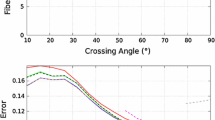Abstract
We investigate optimal diffusion tensor imaging (DTI) acquisition parameters including the number of diffusion encoding directions (K), the number of excitations at each direction (N e ) and diffusion weighting (b-value). A time efficiency measure is proposed for parameter optimization to achieve the best compromise between the accuracy of estimated fiber tracts and scan time in spin echo single shot echo-planar imaging (EPI). By simulation with four synthetic datasets, we conclude that six encoding directions and one excitation give the highest time efficiency when single image SNR0 measured at b-value= 191.14 mm − 2 s is larger than 32. The optimal number of excitations increases to two when SNR0 is smaller than 32. Further increase of K and N e would decrease time efficiency. And the optimal b-value decreases as SNR0 increases. Finally, we validate the findings by comparing the time efficiency of two sets of acquisition parameters using real dataset, and marked lift is observed when the optimal set is applied.








Similar content being viewed by others
References
Stejskal, E. O., & Tanner, J. E. (1965). Spin diffusion measurements: Spin echoes in the presenceof a time-dependent field gradient. Journal of Chemical Physics, 42, 288–292.
Melhem, E. R., Mori, S., & Mukundan, G. (2002). Diffusion tensor MR imaging of the brain and white matter tractography. AJR, 178, 3–16.
Torrey, H. C. (1956). Block equations with diffusion terms. Physical Review, 104, 563–565.
Hasan, K. M. (2007). A framework for quality control and parameter optimization in diffusion tensor imaging: Theoretical analysis and validation. Magnetic Resonance Imaging, 25, 1196–1202.
Melhem, E. R., Itoh, R., Jones, L., Barker, P. B., Jones, L., & Barker, P. B. (2000). Diffusion tensor MR imaging of the brain: Effect of diffusion weighting on trace and anisotropy measurements. AJNR, 21, 1813–1820.
Burdette, J. H., Elster, A. D., & Ricci, P. E. (1998). Calculation of apparent diffusion coefficients in brain using two-point and six-point methods. Journal of Computer Assisted Tomography, 22, 792–794.
Hasan, K. M., Parker, D. L., & Alexander, A. L. (2001). Comparison of gradient encoding schmes for diffusion-tensor MRI. Magnetic Resonance Imaging, 13, 769–780.
Jones, D. K. (2004). The effect of gradient sampling schemes on measures derived from diffusion tensor MRI: A Monte Carlo study. Magnetic Resonance in Medicine, 51, 807–815.
Jones, D. K., Horsfield, M. A., & Simmons, A. (1999). Optimal strategies for measuring diffusion in anisotropic systems by magnetic resonance imaging. Magnetic Resonance in Medicine, 42, 515–525.
Leemans, A., Sijbers, J., Verhoye, M., Van der Linden, A., & Van Dyck, D. (2005). Mathematical framework for simulating diffusion tensor MR neural fiber bundles. Magnetic Resonance in Medicine, 53, 944–953.
Mori, S., Crain, B. J., Chacko, V. P., & van Zijl, P. C. M. (1999). Three dimensional tracking of axonal projections in the brain by magnetic resonance imaging. Annals of Neurology, 45, 265-269.
Lazar, M., & Alexander, A. L. (2003). An error analysis of white matter tractography methods: Synthetic diffusion tensor field simulations. NeuroImage, 20, 1140–1153.
Otsu, N. (1979) A threshold selection method from gray-level histograms. IEEE Transactions on Systems, Man, and Cybernetics, 9, 62–66.
Hofer, S., & Fraham, J. (2006). Topography of the human corpus callosum revisited-comprehensive fiber tractography using diffusion tensor magnetic resonance imaging. Neuro Image, 32, 989–994.
Pajevic, S., Aldroubi, A., & Basser, P. J. (2002). A continuous tensor field approximation of discrete DT-MRI Data for extracting microstructural and architectural features of tissue. Journal of Magnetic Resonance, 154, 85–100.
Hasan, K. M. (2005). DTI parameter optimization at 3.0T: Potential application in entire normal brain mapping and multiple sclerosis research. Medicamundi, 49, 30–45.
Author information
Authors and Affiliations
Corresponding author
Rights and permissions
About this article
Cite this article
Zheng, B., Rajapakse, J.C. Time Efficient DT-MRI Acquisition Parameters for Robust Estimation of Fiber Tracts. J Sign Process Syst Sign Image Video Technol 54, 25–31 (2009). https://doi.org/10.1007/s11265-008-0192-8
Received:
Revised:
Accepted:
Published:
Issue Date:
DOI: https://doi.org/10.1007/s11265-008-0192-8




